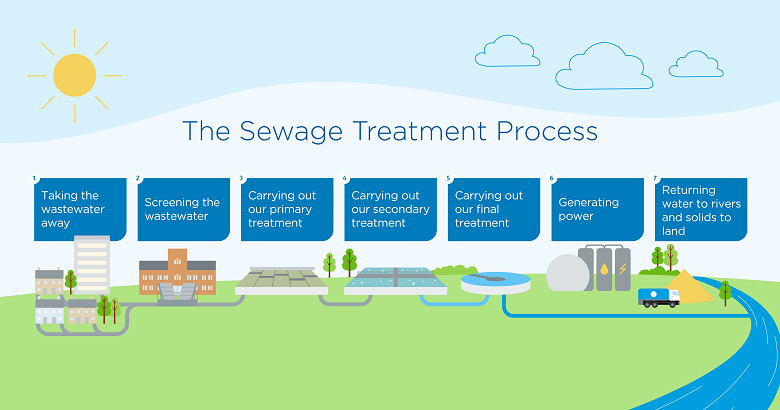Strategic Approaches to Enhance Drainage Treatment Performance and Reduce Environmental Impact
In the realm of waste water treatment, the pursuit for boosted effectiveness and minimized environmental influence is a perpetual difficulty that demands strategic options. The assimilation of advanced therapy innovations, energy-efficient processes, resource recuperation techniques, improved nutrient removal strategies, and clever monitoring and control systems represents a multifaceted framework for attending to these pressing concerns.
Advanced Therapy Technologies
Cutting-edge membrane purification systems have changed innovative wastewater therapy procedures, significantly enhancing the elimination of contaminants. These ingenious systems function forcibly water via a semi-permeable membrane, efficiently dividing pollutants from the water stream. The membrane layer's microscopic pores catch pollutants such as bacteria, viruses, and suspended solids, enabling only purified water to pass through. This innovation has actually shown to be highly effective in removing a wide variety of contaminants, including pharmaceuticals, heavy steels, and organic substances, which are commonly challenging to remove via typical treatment techniques.
In addition, membrane layer purification systems use countless advantages over standard treatment methods. In addition, these systems are very functional and can be easily incorporated right into existing treatment plants or used as standalone devices for decentralized applications.
Energy-Efficient Procedures
The assimilation of energy-efficient procedures in wastewater treatment systems is critical for optimizing resource utilization and lowering functional costs. By implementing energy-efficient technologies, therapy plants can significantly decrease their carbon footprint and total ecological impact. One vital approach to enhancing energy performance in wastewater treatment is the utilization of innovative aeration systems, such as great bubble diffusers or surface aerators, which can boost oxygen transfer efficiency and decrease energy consumption. Additionally, including energy healing systems, like anaerobic food digestion for biogas manufacturing or using excess heat for thermal processes, can assist balance out power needs and advertise sustainability.
Moreover, maximizing procedure control and automation with making use of innovative sensing units and keeping an eye on systems can improve general energy efficiency by readjusting operations in real-time based upon actual demand and problems. Applying power audits and routinely keeping track of energy efficiency indications are essential methods to determine areas for renovation and track energy-saving efforts efficiently. Generally, the adoption of energy-efficient processes in wastewater treatment not just profits the setting but likewise adds to long-lasting expense financial savings and operational sustainability.
Resource Healing Methods
With a concentrate on maximizing source application and sustainability in wastewater therapy systems, the application of source healing methods emerges as an essential element in boosting operational efficiency. Source healing methods in wastewater therapy entail the identification and removal of beneficial sources from the waste stream, consequently transforming what was once considered waste into a valuable property. By implementing resource healing strategies such as nutrient elimination and recuperation, power generation from raw material, and the manufacturing of recyclable water, wastewater therapy plants can lessen environmental effect while taking full advantage of efficiency.

Boosted Nutrient Removal Strategies
Carrying out advanced nutrient removal techniques is essential for optimizing the effectiveness of wastewater therapy systems. Enhanced nutrient click here for info removal plays an important role in decreasing the environmental influence of cured effluent discharged right into water bodies. One of the essential methods utilized for enhanced nutrient elimination is the process of organic nutrient elimination (BNR), which involves the elimination of nitrogen and phosphorus via biological procedures. This can be accomplished through using specialized bacteria that can transform nitrogen substances into inert nitrogen gas through denitrification, and accumulate phosphorus within their cells through a procedure called improved biological phosphorus elimination (EBPR)

In enhancement to BNR, advanced therapy techniques such as membrane layer bioreactors (MBRs) and created marshes can also be used to boost nutrient removal efficiency. By including these innovative nutrient removal methods right into wastewater therapy systems, districts and markets can effectively minimize nutrient contamination and safeguard the setting.
Smart Tracking and Control Solution
Making use of sophisticated modern technology, the integration of clever monitoring and control systems transforms the operational effectiveness of wastewater treatment facilities. These systems incorporate innovative sensing units and data analytics to continually keep track of key parameters such as pH degrees, turbidity, dissolved oxygen, and flow prices you can look here in real-time. By accumulating and analyzing this information, drivers can acquire important insights right into the performance of the therapy processes, making it possible for aggressive adjustments to optimize treatment effectiveness.
Smart monitoring and control systems additionally sustain remote surveillance capabilities, allowing operators to accessibility real-time data and control functions from off-site places. This remote availability enhances functional adaptability and responsiveness, enabling speedy treatments in instance of system breakdowns or variations in influent quality. The anticipating maintenance abilities of these systems help stop devices failings and reduce downtime, eventually improving the total dependability of wastewater therapy procedures.
Verdict
In verdict, strategic methods such as innovative therapy modern technologies, energy-efficient procedures, resource recuperation techniques, enhanced nutrient elimination strategies, and clever monitoring and control systems play a vital duty in enhancing wastewater treatment performance and minimizing environmental influence. By carrying out these strategies, wastewater treatment plants can improve their total efficiency, reduce power intake, recoup important sources, and make sure conformity with ecological guidelines. These techniques are important for efficient and sustainable wastewater administration techniques.

In verdict, critical methods such as advanced treatment technologies, energy-efficient processes, resource healing methods, improved nutrient removal strategies, and smart surveillance and control systems play a vital role in improving wastewater therapy efficiency and lessening ecological effect.